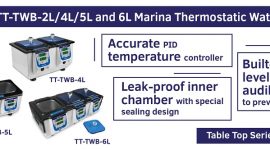28 May
2018
Common FAQ of Centrifuges
The concept of a centrifuge was first born from an English military engineer Benjamin Robins and later put into practice in 1875 by Alexander Prandtl based on his brother’s idea of a dairy centrifuge to separate cream from milk. Since the creation, various developments have been undertaken to produce a wide range of models for different applications, contributing to the advancement of science and technology. Being a common sight in most laboratories, it is therefore imperative to understand some basic knowledge about centrifuges. We list the top 5 questions often asked by users.
1. How do I balance my samples?
If you only have one sample to run, make sure to put another tube with the same volume of water in the opposite hole. Balancing by mass is recommended if the density of sample and water is different. Check rotor holes for any spill or leftover residue from previous run, remove if any, as they may lead to unbalanced operation. If you only have one sample to run, make sure to put another tube with the same volume of water in the opposite hole. Balancing by mass is recommended if the density of sample and water is different. This practice is critical and may just save your life and others in the lab.
If you only have one sample to run, make sure to put another tube with the same volume of water in the opposite hole. Balancing by mass is recommended if the density of sample and water is different. Check rotor holes for any spill or leftover residue from previous run, remove if any, as they may lead to unbalanced operation. If you only have one sample to run, make sure to put another tube with the same volume of water in the opposite hole. Balancing by mass is recommended if the density of sample and water is different. This practice is critical and may just save your life and others in the lab.
2. How do we maintain the rotors and interior of the centrifuge?
The rotors and interior should be cleaned on a monthly basis. Unplug the power cord and remove the rotor. Use a soft, moist cloth and neutral cleaning solutions (alcohol or alcohol-based disinfectant) to clean the rotor and interior chamber. For disinfection purpose, diluted 70% ethanol can be used. Do not pour water directly into the chamber. Any spill should be wiped immediately before using. After wiping or rinsing the rotor with clean water, leave it to dry before installing.
The rotors and interior should be cleaned on a monthly basis. Unplug the power cord and remove the rotor. Use a soft, moist cloth and neutral cleaning solutions (alcohol or alcohol-based disinfectant) to clean the rotor and interior chamber. For disinfection purpose, diluted 70% ethanol can be used. Do not pour water directly into the chamber. Any spill should be wiped immediately before using. After wiping or rinsing the rotor with clean water, leave it to dry before installing.
3. What other tips or safety precautions should we take while using the centrifuge?
Always place the centrifuge on a flat and firm surface. Never try to open the lid while it is running. If the centrifuge starts wobbling or shaking drastically, pull off the power cord immediately. Always check the tubes for cracks because cracks can cause spillage while running and lead to imbalance operation
Always place the centrifuge on a flat and firm surface. Never try to open the lid while it is running. If the centrifuge starts wobbling or shaking drastically, pull off the power cord immediately. Always check the tubes for cracks because cracks can cause spillage while running and lead to imbalance operation
4. How to open the lid in case of power failure?
Upon power failure while running, often times, lids have to be opened manually. As different models have different methods for opening the lid, we recommend users to always refer to the manufacturers’ manual for proper instructions.5. Are the rotors autoclavable?
Some rotors are fully autoclavable within 120°C, while others are not. It is advisable to always refer to the manufacturers’ manual for proper instructions.
Upon power failure while running, often times, lids have to be opened manually. As different models have different methods for opening the lid, we recommend users to always refer to the manufacturers’ manual for proper instructions.5. Are the rotors autoclavable?
Some rotors are fully autoclavable within 120°C, while others are not. It is advisable to always refer to the manufacturers’ manual for proper instructions.






